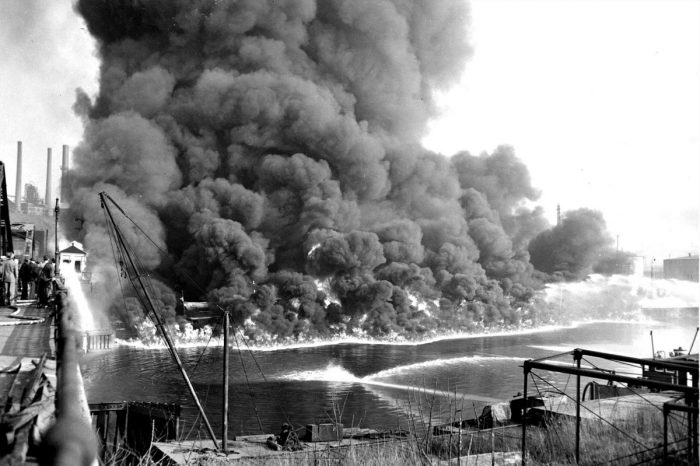
When the final fire to ignite on the Cuyahoga River blazed in June 1969, water quality concerns were far from the nation’s mind. Yet when Time magazine ran the story later that August, recycling a photo from a worse 1952 fire, Cleveland’s burning river rocketed to national prominence, which ultimately led to the adoption of the Clean Water Act in 1972.
Uninhabitable to any fish species between Akron and Cleveland, this Ohio river was considered one of the most polluted in the United States. Between 1868 and 1969, 13 fires caused over $1 million in damages. The water of the Cuyahoga ran black from oil and grease, and by the late 1960s, discharge from factories and detergent chemicals had created foam on the water’s surface. As Time magazine described, this was a river that “oozes rather than flows.”
The 1969 fire only lasted 20 minutes; however, it became the cornerstone for protecting water across the country. The ensuing public alarm and outcry began a movement to control water pollution both physically within industrial settings and through legislative means. This movement, gaining traction from increased environmental awareness across the states, led to the formation of the federal Environmental Protection Agency and the Ohio Environmental Protection Agency in 1970, followed by the Clean Water Act and Great Lakes Water Quality Agreement in 1972.
Considered the foundation for protecting surface water quality in the United States, the Clean Water Act regulates the discharge of pollutants from the point of source to any navigable waters unless a permit is secured. Through the subsequent years after its passage, the Clean Water Act has expanded its targets from traditional sources like industry to include various other sources and pollutants, such as stormwater runoff from streets and construction sites and nutrient loads from farming operations. In recent years, the EPA has aimed to take a more holistic approach to improve water quality, focusing on the protection of entire watersheds by restoring impaired and protecting healthy waters.
The ecosystem of the Cuyahoga River has recovered immensely over these past 50 years thanks to ongoing conservation efforts. Recent survey work by Ohio EPA indicates that fish populations in the Cuyahoga River between Akron and Cleveland have achieved Full Attainment of Warmwater Habitat standards. At present, approximately 56 species of fish inhabit this stretch. In total, the mainstem of the Cuyahoga River has 76 unique species of fish according to Ohio EPA.
Although the river has significantly improved, continuous efforts are made to achieve and maintain the best standards for river health and vitality. For the past 30 years, EnviroScience biologists have demonstrated a commitment to water quality in the Cuyahoga River. We support these efforts through our work with river restoration, dam removals, aquatic surveys, and more.